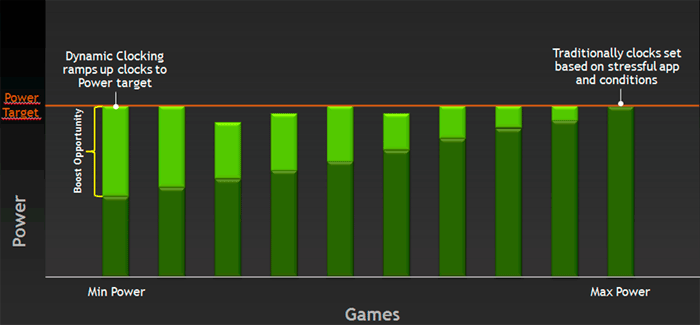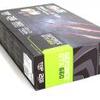Power efficiency
Power efficiency
A smaller 28nm based chip means you can do more with less as the product becomes smaller, the GK106 GPU comes with roughly 2.54 billion transistors embedded into it. The TDP (maximum board power) sits at a very respectable 140 Watts. So in one hand you have a graphics card that uses less power, yet offers more performance. That's always a win.
The GeForce GTX 660 will be released with one 6-pin power connectors to get enough current and a little spare for overclocking. This boils down as: 1x 6-pin PEG = 75W + PCIe slot = 75W is 150W available (in theory). We'll measure all that later on in the article but directly related is the following chapter.
Dynamic Clock Adjustment - The Boost Clock
Kepler GPU features a Dynamic Clock Adjustment technology and we can explain it easily without any complexity. Typically when your graphics card idles the cards clock frequency will go down... yes? Well, obviously Kepler architecture cards will do this as well, yet now it works vice versa as well. If in a game the GPU has room left for some more, it will increase the clock frequency a little and add some extra performance. You could say that the graphics card is maximizing it's available power threshold.
Even more simple, DCA resembles Intels Turbo Boost technology a little bit by automatically increasing the graphics core frequency with 5 to 10 percent when the card works bellow its rated TDP.
The baseclock of the Reference GeForce GTX 660 in 3D mode is 980 MHz, but it can boost towards 1033 MHz. For the different SKUs from board partners these numbers will be different.
The Boost Clock is the average clock frequency the GPU will run under load in many typical non-TDP apps that require less GPU power consumption. On average, the typical Boost Clock provided by GPU Boost in GeForce GTX 660 is 1033MHz, an improvement of just over 5%. The Boost Clock is a typical clock level achieved running a typical game in a typical environment.
However, in many cases the GTX 660 GPU will have additional power headroom available and will automatically increase the Boost Clock even higher than 1033MHz. As long as the GPU remains under its power target, GPU Boost will seamlessly increase the GPU Clock. Speeds of 1084MHz and higher have been observed in many cases.
The 'Boost Clock' however is directly related to the maximum board power, so it might clock even higher as longs as the GPU sticks within it's power target. Overclocking on that end will work the same as GPU boost will continue to work while overclocking, it stays restricted within the TDP bracket. We'll show you that in our overclocking chapter.

3D Vision surround on a Single GPU
Whether or not NVIDIA would like to admit it, ATI's Eyefinity certainly changed the way we all deal with multi-monitor setups. As a result in the series 500 products there was multi monitor support for gaming with three monitors, this is called Surround Vision. The downside here was that you needed at least two cards setup in SLI for this to work.
It would not have made any sense to have not addressed this with Kepler, so Surround vision and 3D Surround vision are now supported with one card That means you can game even in 3D on three monitors with just one GeForce GTX 600 series as the new display engine can drive four monitors at once. Keplers display engine fully supports HDMI 1.4a, 4K monitors (3840x2160) and multi-stream audio.
Using up-to 4 displays
We just had a quick chat about 3D Vision surround but Kepler goes beyond three monitors. You can connect four monitors, use three for gaming and setup one top side (3+1) monitor to check your email or something desktop related.
Summing up Display support
- 3D Vision Surround running off single GPU
- Single GPU support for 4 active displays
- DisplayPort 1.2, HDMI 1.4a high speed
- 4K monitor support - full 3840x2160 at 60 Hz
In combination with new Desktop management software you can also tweak your desktop output a little like center your Window taskbar at the middle of the three monitors or maximize windows to a single display. With the software you can also setup and apply bezel correction. Interesting though is a new feature that allows you to use hotkeys to see game menu's hidden by the bezel.

PCIe Gen 3
The series 600 cards from NVIDIA all are PCI Express Gen 3 ready. This update provides a 2x faster transfer rate than the previous generation, this delivers capabilities for next generation extreme gaming solutions. So opposed to the current PCI Express slots which are at Gen 2, the PCI Express Gen 3 will have twice the available bandwidth and that is 32GB/s, improved efficiency and compatibility and as such it will offer better performance for current and next gen PCI Express cards.
To make it even more understandable, going from PCIe Gen 2 to Gen 3 doubles the bandwidth available to the add-on cards installed, from 500MB/s per lane to 1GB/s per lane. So a Gen 3 PCI Express x16 slot is capable of offering 16GB/s (or 128Gbit/s) of bandwidth in each direction. That results in 32GB/sec bi-directional bandwidth.

